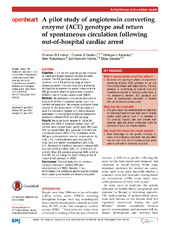A pilot study of angiotensin converting enzyme (ACE) genotype and return of spontaneous circulation following out-of-hospital cardiac arrest
Lindner, Thomas Werner; Deakin, Charles D.; Aarsetøy, Hildegunn; Rubertsson, Sten; Heltne, Jon-Kenneth; Søreide, Eldar
Peer reviewed, Journal article
Published version
Permanent lenke
https://hdl.handle.net/1956/9783Utgivelsesdato
2014-08-14Metadata
Vis full innførselSamlinger
Originalversjon
https://doi.org/10.1136/openhrt-2014-000138Sammendrag
Objective: In the last few years the genetic influence on health and disease outcome has become more apparent. The ACE genotype appears to play a significant role in the pathophysiology of several disease processes. This pilot study aims at showing the feasibility to examine the genetic influence of the ACE genotype on return of spontaneous circulation (ROSC) in out-of-hospital cardiac arrest (OHCA). Methods: We performed a prospective observational study of all OHCAs of presumed cardiac origin in a well-defined population. We collected prehospital blood samples for the determination of ACE genotype and used this information together with Utstein template parameters in a multivariable analysis to examine the relationship between ROSC and ACE genotype. Results: We collect blood samples in 156 of 361 patients with OHCA of presumed cardiac origin, 127 samples were analysed (mean age 67 years, 86% male, 79% witnessed OHCA, 80% bystander CPR, 62% had a shockable rhythm, ROSC 77%). Distribution of the ACE gene polymorphisms: insertion polymorphism (II) n=22, 17%, insertion/deletion polymorphism (ID) n=66, 52% and deletion polymorphism (DD) n=39, 31%. We found no significant association between ACE II vs ACE DD/DI and ROSC (OR 1.72; CI 0.52 to 5.73; p=0.38). Other ACE genotype groupings (II/ID vs DD or II vs DD) did not change the overall finding of lack of impact of ACE genotype on ROSC. Conclusions: This pilot study did not indicate a significant association between ACE gene polymorphism and ROSC. However, it has demonstrated that prehospital genetic studies including blood sampling are feasible and ethically acceptable.

